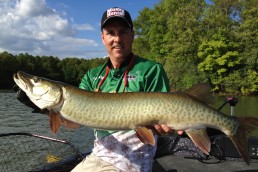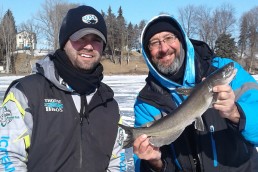Understanding Water Temperature and Catfish
SHARE THIS POST
Fall catfish patterns depend heavily on the fall water temperatures- Learning about water temps for catfish will lead to their locations in bodies of water in the Midwest.
Everything a catfish does in life is based on water temperature. As we all know, fish are cold-blooded creatures which means their body temperature follows the water temperature. This seems pretty obvious if you paid attention in grade school science, but many seem to forget how sensitive to water temperature fish really are.
If you remember back to previous articles in this series, we talk a lot about the annual seasons of a catfish’s year. Each season is triggered by changes in water temperature. Pre-spawn begins when the water temperature reaches about 50 degrees. Spawn kicks in at 70 degrees. The fall pattern begins when the water temperature drops back to the low 60s. This is just touching on how water temperature affects catfish, but you get the point for now.
A quick overview of the sun and temperature
Taking this a step deeper, the water temperature and seasons is directly related to the sun and warming hours that the sun provides. This part is obvious but there are variables in water temperature that is related more to weather than the actual warming hours of the sun.
In the spring, when the water begins to warm up, it is due to the earth being closer to the sun, but also to the sun being out longer each day to provide more warming hours. This explains why the spawn is usually in full force when we hit summer solstice in late June. That is the point when there are the most warming hours each day and when water temperatures are at 70 or more degrees.
In the reverse, the water begins cooling later in the summer and into early fall even though it is still nice, and in some cases hot outside. The warming hours are less and hours under darkness are greater forcing the water temperatures to fall.
Weather variables
There are always variables in weather that will cause water temperature swings. There can be cold fronts or heat waves that roll in and cause rapid changes to water temperature. Both of these, and everything in between, can affect fish and how they act for a day or two to a long-term change.
Like everything else in fishing, sometimes just a small adjustment can help you fish your way through these variables and make the most of your day on the water.
When you get a warming day, the fish will become more aggressive and feed harder, usually in stiffer current. You can shorten your sit times and fish fast. Likewise, if it is a cooling day the fish may go from aggressive to a more sluggish mood.
Every June, when there is the natural warming due to the most warming hours each day the water temperature will inevitably hit 70 degrees. Once the entire water column is 70 for a few days everything we just explained goes out the window as the spawn begins. This will take anywhere from two to five weeks depending on what the water temperature does.
Are you enjoying this post?
You can be among the first to get the latest info on where to go, what to use and how to use it!
If it stays hot and water temps remain in the mid-70s, the spawn is usually shorter. If it cools back off the catfish eggs do not mature as quickly and spawn lasts longer.
Fishing through water temperature changes
We know that water temperature changes throughout the year and during different weather patterns; so how do you fish to changes in water temperature?
In the spring, as water temperatures rise into the mid-50s and 60s, the fish will get more aggressive and start to feed along the main current seams of rivers. Unless the water level is high the fish will move right on the seam and in the faster current areas.
Should there be a situation where the water temperature falls from a cold front, or a sharp water fluctuation, the catfish will move just out of the current. In many cases, you can fish almost the same spots but you need to get out of that main current seam.
If the water temperature rises or falls sharply say 10 to 15 degrees in just a few days the fish will get moody and move off the current. In this case you need to look for structure and current breaks that catfish use to hide and expend the least amount of energy. Sometimes this will last a couple days to a couple weeks depending on how sharp the temperature rise is.
During the midsummer when catfish are not migrating as much they will stick to holes and structure. The same rules as before apply. If the water temperature is stable to rising the fish will be feeding more aggressively at the heads of holes and in outside of snags. Should the water temperature drop from a front or something the fish will move tighter to the wood or more to the middle of the hole. In this case you may have to sit on them a little longer to catch the best fish.
When fall begins to get in the air there is a different phenomenon that happens: the catfish will actually turn on knowing that winter is just around the corner. As long as the temperature is somewhat stable, they will feed and if there is good flow in the river they will pattern just like spring. The fish will be hunting but if there is a cold front that drops the temperature real fast, they will move off the current but right next to it just like spring.
When there is a nice sunny day, just enough to warm the surface even a degree, the catfish will come out to play with aggression. Stay on the move, and keep the bait fresh because it may be one of the last great days.
Everything a catfish does in their lives is based on water temperature. Knowing and understanding some of these changes and being able to identify them and make the subtle changes necessary to stay on fish can make you a much more consistent angler. Remember to watch the temperature trends then find the current seams that appropriately fit the situation and you will have great success catching catfish.
MWO
SHARE THIS POST
Did you enjoy this post?
You can be among the first to get the latest info on where to go, what to use and how to use it!
Brad Durick
Captain Brad Durick is a nationally recognized catfish guide, seminar speaker, and author of the books Cracking the Channel Catfish Code and Advanced Catfishing Made Easy. For more information: redrivercatfish.com or facebook.com/braddurickoutdoors.



